Call Us
+86 136 6007 9809
Call Us
+86 136 6007 9809
Mar. 29, 2023
Insert nuts provide reusable threads and secure, tight-threaded joints. An additional benefit is high load-carrying capability.
PRESERVATION OF THE THREADED JOINT
The primary benefit of using an Insert is that it preserves the threaded joint integrity for the application's life. An additional advantage is the unlimited reusable thread.
PROPER SEATING TORQUE
During the assembly process with a mating component, the screw has to be tightened with sufficient torque to introduce the recommended axial tension to achieve the required load between the screw and Insert threads to prevent loosening. The larger body diameter and body design of the Insert allow the appropriate installation torque to be applied to the screw.
UNAFFECTED BY STRESS RELAXATION
A common problem with bolted joints in plastic applications is that plastic is susceptible to creep or stress relaxation. Under loads well below the elastic limit, plastics will lose their ability to maintain a load. When this occurs, the threaded connection becomes loose. The brass and aluminum thread provide permanent creep resistance for the entire load path of the thread.
ENHANCE LOAD CARRYING
The load-carrying ability of the joint is enhanced by the larger diameter of the Insert nuts as compared to the screw. Inserts nuts are generally twice the diameter of the screw, and that increases the shear surface fourfold. Pull-out resistance can further be enhanced by increased Insert length.
TECHNICAL SUPPORT
Our Insert nuts are designed to maximize and balance tensile (pull-out) and rotational torque performance. Our Application Engineers have the technical know-how and experience to work with our customers to develop a cost-effective solution to meet application requirements.
BROAD PRODUCT RANGE/CAPABILITY
Our leading-edge production technology is suitable for meeting all your specific needs for both long- and short-run requirements at competitive pricing. We offer a broad range of standard products and cost-effective methods of producing special features. Our comprehensive quality concept encompasses not only product quality but also the quality of design and service. Process control, operational discipline, and continuous improvement are the foundation of our mission to exceed our customers' expectations. We are ISO 9001 certified.
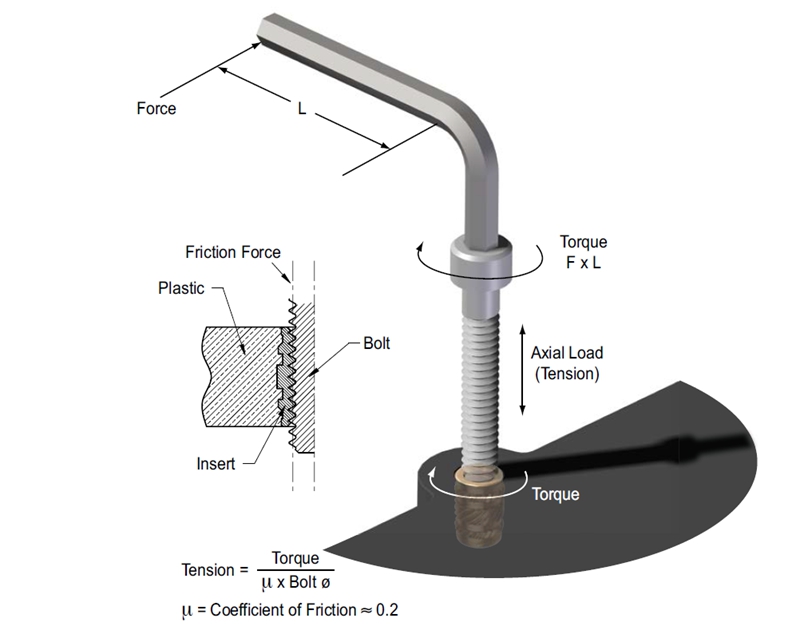
DETERMINING PROPER INSTALLATION
Retention within the hole is provided by the plastic conforming to the external features of the Insert nuts. A sufficient volume of plastic must be displaced to fill these exterior features so that the Insert nuts achieve maximum performance when the plastic solidifies. An accurate way of determining sufficient plastic flow into the knurls, barbs, and undercuts of the Insert nuts is to take a cross-section of the installed Insert nuts and ensure that the features are mirrored in the plastic, as shown in the Figures. It is essential to ensure proper plastic flow into the features of the Insert, as this dictates the torque and pull-out performance. In Figure 2, the plastic did not sufficiently flow into the retention features, resulting in low Insert performance.
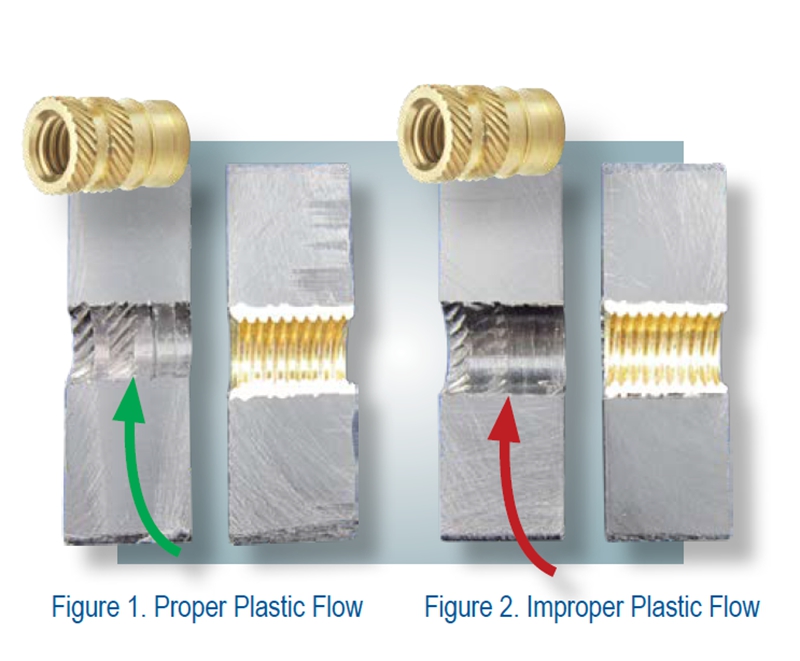
SELF-TAPPING INSERTS NUTS
Provide the best pull-out resistance for a post-mold installed Insert. The threads are designed with a thin profile to minimize inducing stress into the plastic and a relatively coarse pitch to provide the maximum plastic shear surface to resist pull-out. Installation torque is not a problem in that tightening increases the friction between the plastic and threads, and the larger diameter of the external Insert thread increases the frictional surface. Back-out torque performance relies totally on the greater surface area of the external Insert thread and the tension between the threads and plastic. Again, a good pilot is essential to facilitate the square installation to the hole.
PRESS-IN INSERTS NUTS
These Inserts are designed to reduce installation costs by sacrificing torque and pull-out performance. Helical knurls provide torque and pull-out resistance and ensure good plastic flow as the Insert rotates into the hole. Installation torque to achieve sufficient tension between the threads is not a problem in that the helical knurls are designed so that the direction of the installation torque will tend to drive the Insert into the hole — which, of course, is not possible — as the threaded joint is tightened. A pilot is only slightly smaller than the hole, and sufficient length is designed to ensure straight insertion into the hole.
MOLDED-IN INSERTS NUTS
Although generally more costly in getting the Insert into place than the post-mold installation process, this process provides the best performance. Both length and diameter have an impact on pull-out resistance and torque. The challenge is to find the most cost-effective solution that provides/meets the installation torque requirements to achieve an excellent threaded joint and the pull-out values that meet the application load requirements. Helical knurls are the designer's choice to maximize the torque resistance for a given diameter. The volume of these knurls must be such that sufficient plastic is encapsulated in the voids to meet the installation torque requirements for the provided bolt. The amount of plastic trapped in the undercuts of the Insert must be sufficient to achieve the pull-out resistance to which the Insert is subjected while in service. To facilitate insertion into the mold squarely on the core pin, the tolerance of the minor thread diameter is reduced for a good fit between the Insert and these mold core pins. Countersinks are designed to simplify the placement of the Insert on the pin.
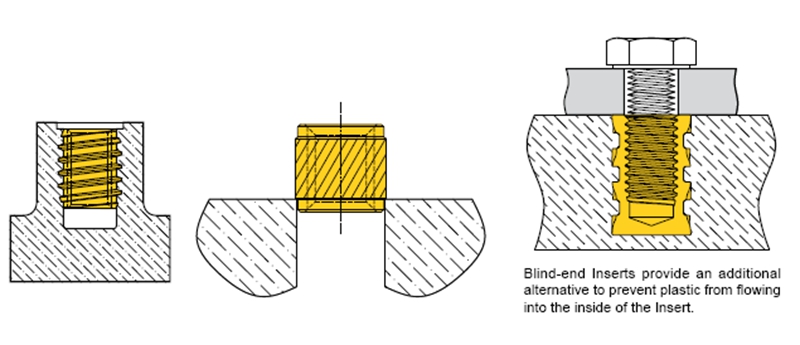
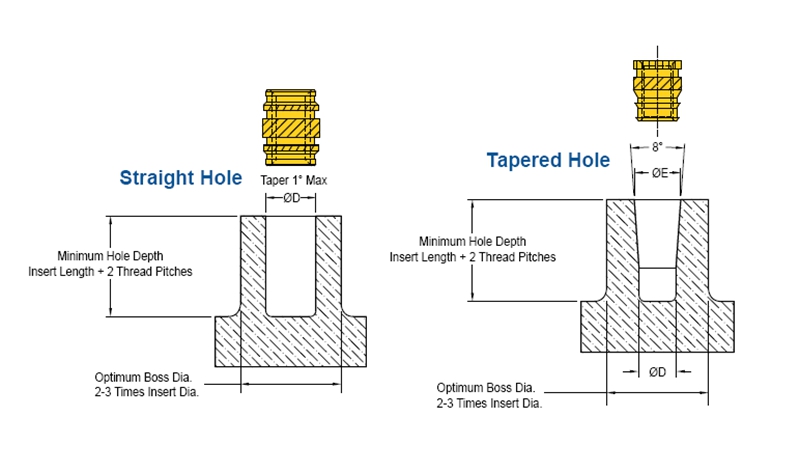
DESIGN GUIDELINES
Holes for post-mold installed Inserts nus should always be more profound than the length of the Insert nuts. A minimum depth of 1.2 times the Insert nut's size is recommended for Self-Tapping insert nuts. The recommended minimum depth for other Inserts is the Insert length plus two (2) Insert thread pitches. The assembly screw should never bottom out in the hole, as a jack-out would result. Counterbores are not recommended for any Insert types except Self-Tapping and Headed Inserts. Counterbores are recommended for Self-Tapping Inserts to reduce the risk of flaking. The outside diameter of the counterbore should be equal to or larger than the outer diameter of the Self-Tapping Insert for the recommended mean counterbore depth "F" corresponding to each Insert size. Counterbores are also recommended for headed inserts so that the top of the Insert will flush with the surface of the plastic after installation. The diameter of the counterbore should be 0.5mm (.02") to 1.3mm (.05") more significant than the head diameter of the Insert. The minimum depth of the counterbore should be specified as the thickness of the head. Insert heads are sometimes left above flush to reduce jack-out or improve match-up with the mating component. The top of the installed Insert should be flush with the surface of the plastic part with a maximum protrusion from the host of 0.13mm (.005"). Additional installation depth tolerance may be assigned to the Insert, which is slightly below flush. Care should be taken to install the top bearing surface of the Insert as close to flush as possible since a sub-flush installation presents a jack-out condition.
Correct hole size is critical. Larger holes decrease performance, while smaller holes induce undesirable stresses and potential cracks in the plastic. Undersized holes may also result in a flash at the hole edge and make the Insert more challenging to install. The recommended holes need to be reviewed if fillers are used. If the filler content is equal to or greater than 15%, it is suggested to increase the hole by 0.08mm (.003"), and if the content is similar to or greater than 35%, the proposed hole increase is 0.15mm (.006"). For intermediate contents, interpolation is presented. Due to the great variety of fillers, plastics, and combinations, consultation with J-X Enterprise is strongly recommended.
Molded holes are preferred over drilled holes. The strong, denser surface of the molded hole increases performance. Core pins should be large enough to allow for shrinkage. For straight holes, the taper should not exceed a 1˚included angle. Tapered holes should have an 8˚ included angle. Tapered holes reduce installation time and ensure proper alignment of the Insert to the hole. Only tapered Inserts should be used in tapered holes. More accessible release from the core pin is an additional benefit. Insert performance is affected by the plastic boss diameter and wall thickness. Generally, the optimum wall thickness or boss diameter is two (2) to three (3) times the Insert diameter, with the relative multiple decreasing as the Insert diameter increases. The wall thickness has to be enough to avoid bulging during installation, and for the boss, the diameters have to be strong enough for the recommended assembly screw installation torque. Poor knit lines will cause failures and reduced Insert performance. Ribs can be added to the boss for added strength.
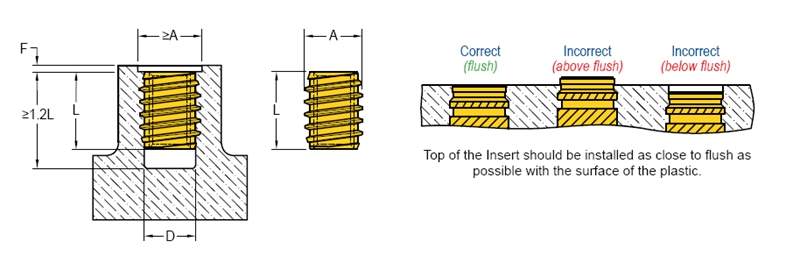
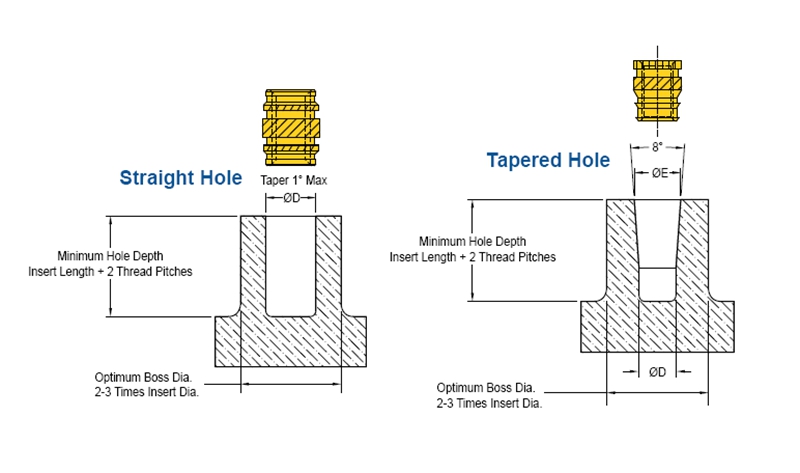
Correct hole size is critical. Larger holes decrease performance, while smaller holes induce undesirable stresses and potential cracks in the plastic. Undersized holes may also result in a flash at the hole edge and make the Insert more challenging to install. The recommended holes need to be reviewed if fillers are used. If the filler content is equal to or greater than 15%, it is suggested to increase the hole by 0.08mm (.003"), and if the content is similar to or greater than 35%, the proposed hole increase is 0.15mm (.006"). For intermediate contents, interpolation is presented. Due to the great variety of fillers, plastics, and combinations, consultation with J-X Enterprise is strongly recommended.
Molded holes are preferred over drilled holes. The strong, denser surface of the molded hole increases performance. Core pins should be large enough to allow for shrinkage. For straight holes, the taper should not exceed a 1˚included angle. Tapered holes should have an 8˚ included angle.
Tapered holes reduce installation time and ensure proper alignment of the Insert to the hole. Only tapered Inserts should be used in tapered holes. More accessible release from the core pin is an additional benefit.
Insert performance is affected by the plastic boss diameter and wall thickness. Generally, the optimum wall thickness or boss diameter is two
(2) to three (3) times the Insert diameter, with the relative multiple decreasing as the Insert diameter increases. The wall thickness has to be enough to avoid bulging during installation, and for the boss, the diameters have to be strong enough for the recommended assembly screw installation torque. Poor knit lines will cause failures and reduced Insert performance. Ribs can be added to the boss for added strength.
Post-mold installed insert nuts cold-pressed into the hole require larger boss diameters and wall thickness to withstand the more significant stresses induced during installation. Installing the Inserts while the plastic is still warm from molding generally eliminates this need. The diameter of the clearance hole in the mating component is critical. The Insert and not the plastic must carry the load. The hole in the mating component must be larger than the outside diameter of the assembly screw but smaller than the pilot or face diameter of the Insert. This prevents jack-out. A headed Insert should be considered if a giant hole in the mating component is required for alignment. Inserts should be installed flush (or no more than 0.13mm (.005") above the hole).
1. If the mating component is plastic, a Compression limit should be considered to maintain the preload of the threaded joint. For the Compression Limiter to work correctly, it should be about the Insert so that the Insert, not the plastic, carries the load.
2. Insert heads to provide a larger bearing surface and a conductive
surface if required. The head also facilitates the plastic flow into the upper knurls and grooves for Heat/Ultrasonic Inserts. In high-load applications, locating the head opposite the load in a pull-through configuration warrants design consideration.
3. Tapered inserts should NOT be used in pull-through applications or thin-walled bosses, as this will cause the plastic to crack.

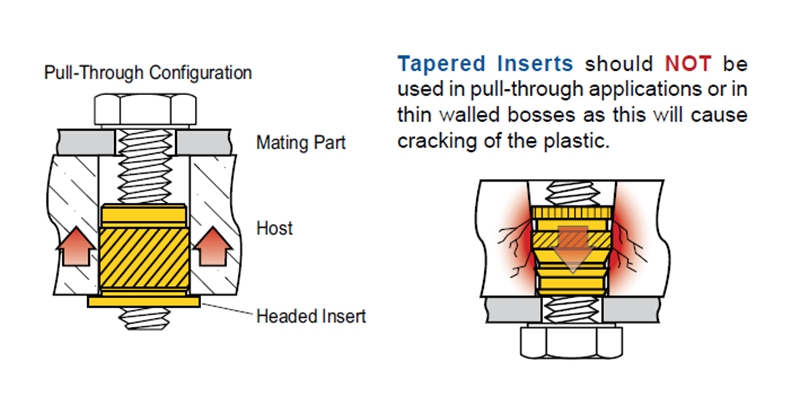
STANDARD MATERIALS&ORDER DESCRIPTION
| Type | Grade | INS (Series #) / Thread Size / Length Material Finish Example: INS 29 / 8-32 / .321L EK | |||||||
| A - Aluminum High Strength Aluminum Alloy | ASTM B211 2024 ISO AlCu4Mg1 | ||||||||
| E - Brass Free-Cutting Brass | ASTM B16 UNS C36000 EN 12164 CW603N CuZn36Pb3 | ||||||||
| RoHS compliant | |||||||||
Contact Us
Tel.:
+86 020 8621 0320
+86 020 3121 6067
Technical Support:
Navigation
SEND INQUIREY